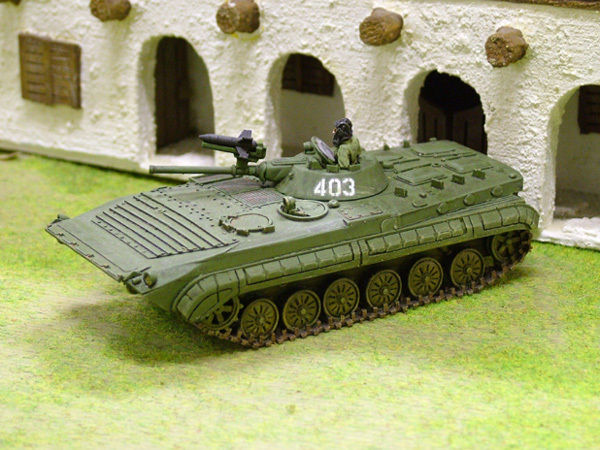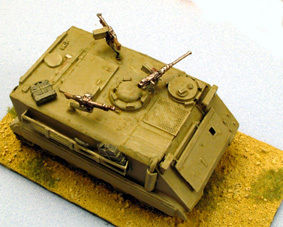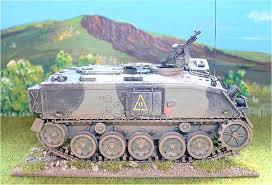Description
1/56th Scale resin & white metal kit of Soviet BMP1
The BMP-1 (Boevaya Mashina Pekhota – Infantry Fighting Vehicle) was a revolutionary design when it first appeared in the mid 1960s. First seen by the West in the 1967 May Day parade, it was codenamed the M1967 until its Russian designation was known. It replaced the earlier BTR-50P and is used in conjunction with the later wheeled series of BTR carriers.
The BMP design is not just a simple `battle taxi` like the M113. The BMP is designed to support its dismounted troops with its innovative anti armour and antipersonnel weapon suite. It was the first true infantry fighting vehicle. The original design carries a single anti tank missile on the barrel, the 9M14 Malyutka (NATO designation AT-3 Sagger). This was capable of a range of 3000m and defeating any tank at the time of introduction. Reloading is slow, through a special rectangular hatch in the front of the turret. Four reloads are carried. The gunner connects the wires to the missile and leans out to place the missile on the rack. The BMP gunner is unique because he is armed with a stick, to fold the fins of the missile out before firing. The turret is also armed with a 73mm low pressure gun and a coaxial PT machinegun. The 73mm gun (the 2A28 `Grom`) fires fin stabilised HEAT (high explosive anti tank) or high explosive rounds fed by an autoloader from a 40 round magazine. The effective range is 1000m.
Armour is minimal, to stop heavy machinegun rounds to the front and small arms to the side and rear. The vehicle carries 8 combat troops sitting facing outwards to the hull. They sit 4 per side and they can use their small arms to shoot out the side as the vehicle moves along. The first port accommodates the RPK or PK machinegun while the rest will fit the AKM. This means that the BMP squads were intended to have two machineguns per squad; However in practice the second machinegun is dropped for the RPG gunner (who is always accompanied by a loader). Each firing port is provided with a heated view port and a fume extractor. There is room for one RPG-7 or one SA-7 Grail (usually one per platoon), both of which can be fired from a top hatch. The vehicle is NBC protected, relying on overpressure.
The engine is placed at the front of the vehicle, offering some extra protection with the engine block for the crew. It provides 300 horse power and a top speed of 60kph loaded over flat ground with good fuel. The fuel is contained in the rear doors. This may be an unusual position, but is far away from the engine & hostile fire from the front. In addition, the doors are designed so if the fuel does explode, it is vented upwards not into the crew compartment. All the BMP track components are based on the PT-76 Tank series and its offshoots (MT-LB, SP-74, BTR-50, and ASU-85 to name but a few). The BMP is amphibious, being propelled by its tracks in the water. IR spotlights are provided for the driver, commander and gunner.
The BMP is designed to operate closely with Soviet armour, the tanks would form a vanguard with the BMPs following close behind, unloading their infantry close to the target. Each BMP has side lights to enable the BMPs to remain in formation in dark or poor conditions. This light on the BMP 1 is located between the first and second vision port behind the turret. The BMP is not designed to be used as a tank and it does not perform well when it is used as one (with combat experience in the Middle East and Africa). However in Afghanistan, the Soviet BMPs were known to drop off their infantry and then operate in fire support groups (called Bronegruppe), acting as a mobile reserve.
The BMP-2 is an improved model introduced in 1980 and first `seen` in the 1982 May Day parade. Armed with a two man turret containing a Shipunov 2A42 30mm AA Cannon, it is also fitted with the more modern 9M111 Fagot (AT-4 Spigot) or 9M113 Konkurs (AT-5 Spandrel) missiles. The cannon is designed to engage lightly armoured targets and low speed aircraft and helicopters. The number of troops carried drops to seven. The 30mm gun was ideal for Afghanistan, as it could engage high targets in the valleys where other Soviet tank guns did not have the elevation.
Both the BMP 1 and BMP 2 have seen wide use all over the world and still in service (in modernised forms) with the Russian confederation. More modern versions have upgraded for newer missiles and are designed to accommodate more modern weaponry (AK 74, RPG 16 and SA 14). A few BMPs in the field have been seen retrofitted with pintle mounts, notably for the AGS-30 `Plasmaya` Auto Grenade Launcher in the latter part of the Afghan war. The upgraded modernised BMP 1P is fitted with an AT-4 or AT-5 launcher mounted on the top of the turret. Smoke dischargers are a common addition.
The newer BMP3 (introduced in 1990) is rarely seen; most are either given to elite units or sold for export.
Models of the BMP 1 were made under licence in Romania, China and Czechoslovakia. The vehicle was widely used by the Warsaw Pact and is still by some former members. The BMP 1 and 2 have been exported as far and wide and has seen service in serves Afghanistan, Afghanistan, Bulgaria, Cuba, Egypt, Germany, Finland, Greece, Hungary, India (who built a licensed BMP-2), Iraq, Kazakhstan, North Korea, Libya, Poland, Slovakia, Syria, Ukraine, Vietnam and Yemen.





Reviews
There are no reviews yet.